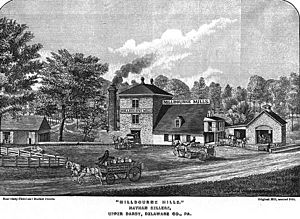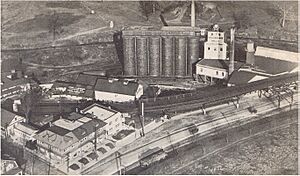Millbourne Mills (Pennsylvania) facts for kids

A depiction of Millbourne Mills by Nathan Sellers
|
|
| Industry | Food processing |
|---|---|
| Founder | Sellers family |
| Defunct | 1927 |
| Headquarters | , |
| Products | Flour |
| Brands | King Midas Flour |
Millbourne Mills was a large flour mill in Upper Darby Township, Pennsylvania, USA. It was owned by the Sellers family. The name "Millbourne Mills" also referred to a railroad station located at the mill.
The mill was an important hub for transportation. The Pennsylvania Railroad's Cardington Branch ended there. This allowed goods to be moved between the Pennsylvania Railroad and the Philadelphia and Western Railroad. The mill also sent products to the Philadelphia and West Chester Traction Company and the Philadelphia Rapid Transit Company. However, trains from these two companies could not directly connect with the mill's tracks. This was because their rail gauge (the distance between the rails) was different. Millbourne Mills was famous for making flour under the brand name King Midas Flour.
Contents
History of Millbourne Mills
The Sellers Family and Early Mills
The area known as Millbourne Borough was first settled by Samuel Sellers. He used the land for living and farming for more than 50 years. Later, his grandson, John Sellers, bought more land in the borough.
Before Samuel Sellers passed away in 1804, he left his properties to his sons: Nathan, David, John, and George. He planned for grist mills (which grind grain into flour) and sawmills (which cut wood) to be built for his son, John Jr. These mills were built before 1749.
The older Sellers owned these mills. They were run by James Steel. James continued to operate the mill until 1805. Then, his son, Thomas Steel, took over the work.
Growing the Mill Business
In 1814, Thomas Steel bought another mill called the Darby Mill. In the same year, the Sellers family built a new part of what would become the Millbourne Mill. John Jr. learned how to be a miller from Thomas Steel. After learning the trade, John Jr. took charge of the new Millbourne Mill.
A stream flowed into the Millbourne dam, providing water power for the mills. Around 1800, there was an oil-mill on this stream, which operated until 1848. An even older grist-mill stood near the current mill. In 1820, this old mill was used to grind gypsum, a mineral. Later, around 1830, a person named Augustus C. Jones used the old mill to grind things like logwood and spices. This mill was eventually closed. The newer mill, built in 1814, was managed by John Sellers, Jr. It had all the best machinery of that time.
The Early 1900s
In the early 1900s, Fred Shane and George Shane owned Millbourne Mills. In 1912, the Shane brothers worked with W.J. Wilson to buy another flour mill. This mill was in Hastings, Minnesota, and was called Gardner Mills.
At first, this purchase was successful. However, expanding too quickly caused money problems for the mill. After Wilson and the Shane brothers bought Gardner Mills, they changed its name to the King Midas Mill. They chose this name because it was the brand name of the flour already made at Millbourne Mills.
What Happened to Millbourne Mills?
Millbourne Mills closed its doors in 1927. After the mill closed, a Sears department store was built at that location. This Sears store was later torn down.
Today, Millbourne is still a small borough in Delaware County, Pennsylvania. It is located between Upper Darby Township and the city of Philadelphia. People can travel to Millbourne using the Millbourne Station on the SEPTA Market-Frankford Line.


